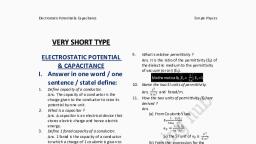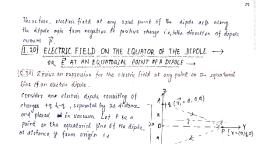Page 1 :
Term [, , Sub -Physicp, Model” Tet, ———, , Time: 90 Minutes Max. Marks 35, , General Instructions:, , 1, The Question Paper contains three sections., , 2. Section A has 25 questions. Attempt any 20 questions., 3. Section B has 24 questions. Attempt any20 questions., 4. Section C has 6 questions. Attempt any 5 questions., 5. All questions carry equal marks., , 6. There is no negative marking., , SECTION A, , This section consists of 25 multiple choice questions with overall choice to, attempt any 20 questions. In case more than desirable numberof questions are, attempted, ONLY first 20 will be considered for evaluation., , Q1.Which of the following is NOT the property of equipotential surface?, (i) They do not cross each other., (ii) The rate of change of potential with distance on them is zero., (ili) For a uniform electric field they are concentric spheres., (iv) They can be imaginary spheres., , Q2. Two point charges +8q and -2q are located at x=0 and x=L respectively., The point on x axis at which net electric field is zero due to these, , charges |s() 8L, (iy 4k, di) 2k, , (ivy ok
Page 2 :
US. AN GISCITIC GIpOre OT MOMEnN p IS placed paraire to Ine UNO Seciic, field. The amount of work done in rotating the dipole by 90-is, (i) 2p, (il) pE, (il) pE/2, (Iv) Zero, , Q4, Three capacitors 2yF, 3yF and 6yF are joined in series with each other., The equivalent capacitance is, (i) 1/2pF, (ii) 1pF, (ill) QpF, (iv) 11 pF, , Q5. Two point charges placed in a medium of dielectric constant 5 are at a, distance r between them, experience an electrostatic force ‘F’. The, Siectromete Perce Deteee Heme ip Neca at the same Sutenee } ee, , (i) SF, (i) F, (ii) F/2, (iv) F/S, Q6. Which statement is true for Gauss law, (i) All the charges whether inside or outside the gaussian surface contribute to, the electric flux., , (ii) Electric flux depends upon the geometry of the gaussian surface., (ili) Gauss theorem can be applied to non-uniform electric field., , (iv) The electric field over the gaussian surface remains continuous and, uniform at every point., , Q7.A capacitor plates are charged by a battery with ‘V' volts. After charging, battery Is disconnected and a dielectric slab with dielectric constant 'K’, is Inserted between its plates, the potential across the plates of a, , capacitor will become, () Zero, , (i) = we, , (ii) =. VK, , (wv) KV
Page 3 :
45. ING DSS INSUUMEMN TOl SCCUISIe Measurement OF CMr O18 Cen Is(i) Potentiometer, (i) metre bridge, (ill) Voltmeter, (iv) ammeter and voltmeter, , Q9.An electric current is passed through a circult containing two wires of, same material, connected in paraliel. if the lengths and radii of the wires, are in the ratio of 3:2 and 2:3, then the ratio of the current passing, through the wire will be, , () 23, qi) = 3:2, (ii) = 8:27, (lv) 27:8, Q10.By increasing the temperature, the specific resistance of a conductor and, @ semiconductor, (i) increases for both., , (i) decreases for both., , (iii) increases for a conductor and decreases for a semiconductor., , (iv) decreases for a conductor and increases for a semiconductor., Q11.We use alloys for making standard resistors because they have, , (i) low temperature coefficient of resistivity and high specific resistance, , (i) high temperature coefficient of resistivity and low specific resistance, , (ili) low temperature coefficient of resistivity and low specific resistance, , (iv) high temperature coefficient of resistivity and high specific resistance, , Q12. A constant voltage is applied between the two ends of a uniform, metallic wire, heat ‘H’ is developed in it. if another wire ofthe same, material, double the radius and twice the length as compared to, original wire is used then the heat developed in it will be, () HI, (i) oH, , (ill) 2H, (wv) 4H
Page 4 :
UIs. Ine Polenta! Girerence Vv appred BCrOss 8 COMOUCTO! I5 Increasea, to 2V with its temperature kept constant, the drift velocity of the, free electrons in a conductor will , (i) remain the same., , (i) become half of its previous value., (iil) be double of its initial value., , (iv) become zero., , Q14.The equivalent resistance between A and B is62 ‘ pan R, aA B, , 300, () 3 ohms, , (i) 55 ohms, (ii) 7.5 ohms, (iv) 9.5 ohms, Q15. The SI! unit of magnetic field intensity is, , (i) Amn", (i) NA‘, , (ii) NA?m*, (iv) NA'm?, , Q16.The coil of a moving coil galvanometer is wound over a metal, frame in order to, , 0] reduce hysteresis, , (li) increase sensitivity, , (iii) increase moment of inertia, , (lv) provide electromagnetic damping, , Q17.Two wires of the same length are shaped into a square of side 'a' and a, circle with radius ‘r’. If they carry same current, the ratio of their, magnetic moment is, , ()), , (i), (ul), (lv), , faan, , 7, 72, 4, , T
Page 5 :
U6. Ne NOTZON! COMPONent Of Cann 5 Magneve ew ats piece is vs umes, the vertical component. The angle of dip at that place is, (i) 16, (i) WwW, (il) ~—ow4, (vw) Oo, , Q19. The small angle between magnetic axis and geographic axis at a, place is, @ Magnetic meridian, (i) Geographic meridian, (ili) ~~ Magnetic inclination, (wv) Magnetic Declination, , Q20.Two coils are placed close to each other. The mutual inductance of, the pair of coils depends upon the, (i) rate at which current change in the two coils, (ii) relative position and orientation of the coils, (iil) rate at which voltage induced across two coils, (iv) currents in the two coils, , Q21. A conducting square loop of side 'L' and resistance 'R' moves in its, plane with the uniform velocity ‘v' perpendicular to one of its, sides. A magnetic induction ‘B’ constant in time and space, pointing perpendicular and into the plane of the loop exists, everywhere as shown in the figure. The current induced in the, , loop is By xe x inside, , , , , , , , , , x c, x ra, i) BLWR Clockwise x [x « v * "t, x x ee, (ii) — BLW/R Anticlockwise x ¥ ¥ x, (il) 2BLW/R Anticlockwise ne >» " ¥ x x ‘, (iv)Zero, Q22. The magnetic flux linked with the coil (in Weber) is given by, theequation @= St’ + 3+ 16, The Induced EMF in the coil at time, t=4 will be() 27, (i) 43, (ii) -108V, , (iv) 210V












































































